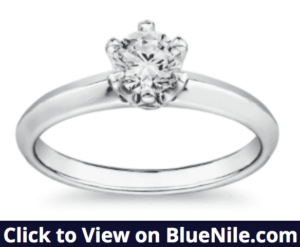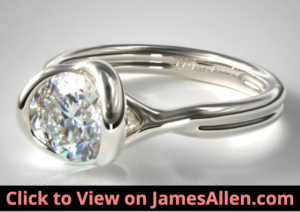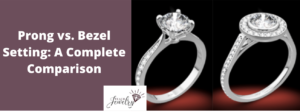
No matter what type of ring you’re interested in buying, there’s a critical piece you need to consider in addition to the diamond: the setting that holds it in place.
While there are a variety of ways to hold your chosen diamond to the ring band, the two tried-and-true options are prong and bezel settings.
The main difference between prong and bezel settings are the way the diamond is held. Prongs are thin claws that extend over the crown to hold it in place. A bezel setting features a ring of metal that forms a circle around the diamond.
We’ll discuss everything you need to know about prong versus bezel settings, including their pros, cons, costs, and how to decide between them.
What is a Prong Setting?
A prong setting features four or more metal prongs rising from the band of the ring that hold the ring in place by its sides.
Take a look at this example of a prong setting in 14K rose gold.
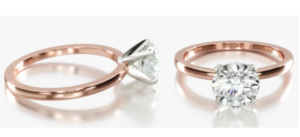
I’ve included views from the front and profile so you can learn how it appears from both angles.
It’s a simplistic design that doesn’t steal attention from the main diamond, especially when it’s part of a solitaire setting.
You may hear this style called a “claw setting,” as the metal prongs often appear claw-like once bent into place. Claw settings are a type of prong that come to a sharp point, but not all prongs have this design. The style above doesn’t fit that category.
What is a Bezel Setting?
A bezel setting is another popular design of securing the diamond in place.
In this case, the metal is wrapped around the edge of the center stone.
Check out the example below, which holds a princess cut.
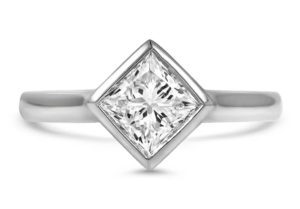
Similar to a prong setting, the metal doesn’t extend too far over the diamond, ensuring the top table facet is 100 percent exposed to maintain its visual appeal.
While the one above wraps all the way around, there are also partial bezel settings, also called semi-, half-, or open bezels.
Pros of a Prong Setting
Fits Most Diamond Shapes
Because of the thin metal prongs, they work for nearly any size or shape of diamond.
The prongs lend themselves to more unique shapes and designs and are easily customizable for whatever type of stone you have.
For example, if you choose a diamond that comes to a pointed end, like a marquise or pear cut, it’ll likely be held with a combination of traditional prongs on the sides a V-prongs at the point.
I’ve highlighted the V-prongs on the marquise cut engagement ring below.
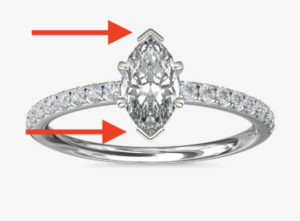
Compare them to the other four.
Another significant pro is they can raise or lower where the diamond sits on the band, so if you decide you want the diamond lifted higher off the ring, new prongs can achieve this look.
This is referred to as a high setting, which increases the prominence of the center diamond and improves its light performance.
Shows More of The Diamond
The most alluring feature of a prong setting is with less surface area required to hold the diamond, the claw setting shows more of the diamond itself.
Both the sides and top are more exposed when using prongs.
This is particularly important regarding the underside of the stone. It allows for better light performance compared to a bezel setting, which covers up more of the light’s entrance into the diamond.
If you’ve chosen a diamond under 0.75 carats, you might consider thin prongs instead of a bezel to maximize how much of its table and crown are exposed to light.
Easier To Clean
Maintenance might not be the first criteria on a potential buyer’s mind when browsing ring options, but it’s worth considering.
Because prongs leave so much space open around the diamond, cleaning is far less difficult. With the right tools and supplies, it’s a relief to have the ability to reach all the way around the diamond and under the nooks and crannies of the claw itself.
That being said, it’s still best to leave cleaning your diamond ring to a professional jeweler.
Variety of Styles
Due to its unique shape, claw settings can be ordered in many distinct styles. You’ll find four-, six-, or even 8-pronged settings when perusing your online or local jewelry store counters.
The example below includes six prongs set equidistant around the gem.
Naturally, the higher number you opt for, the more it secures the stone.
But of course, aesthetics don’t heed logic like that. You may find yourself choosing a setting with fewer prongs or ones with a V-shape simply because you enjoy the look of it.
Tiffany settings are also popular — a specific six-pronged setup that’s incredibly effective at allowing the most light possible to enter through the diamond.
Easier to Reset or Make Adjustments
While prong settings are often secure regardless of the design, it’s no secret the metal is malleable. With such thin arms, the prong settings can give way to extreme strength when being readjusted by a jeweler.
This is a good thing when you’re needing the stone reset in its original position or adjusted to have the desired appearance. While we hope it never comes to that, it’s nice to have the reassurance small changes can be made with relative ease (by a professional).
Cons of a Prong Setting
More Easily Damaged
It’s clear the stone itself is more exposed, and while the risk of damage is there, it’s not a ton to worry about. That’s because diamonds are the hardest natural substance on Earth.
On the other hand, the metal prongs themselves aren’t made of the toughest rock on earth. Chipping is a minor hazard for the diamond but much more apparent in the case of the claw itself.
If the prongs begin showing signs of damage, and one or more bends backwards, I recommend not wearing your ring until it’s fixed. It’s possible the diamond slides out and you lose it, which is a much more significant problem than repairing prongs.
Snags On Clothing
Fabric isn’t as friendly toward the prong setting. That’s because there’s a chance of snagging your ring on clothing.
Even when bent into the right place, it’s difficult to completely avoid the claw catching some fabrics. It isn’t something you have to worry about every time you change clothes, but know it does happen and can require an inconvenient repair.
Pros of Bezel Settings
Security
A bezel setting is the right choice when you’re looking for the maximum protection for your valuable diamond. If your jewelry takes a fall or a hit, the likelihood of the metal taking the brunt of the force is very high.
For example, check out this bezel setting. The setting covers the full outer edge of the round-cut diamond.
While much of the diamond is still exposed for the sake of aesthetics, the amount of surface area present compared to prongs is notable.
Less Frequent Maintenance
Maintenance isn’t necessary as often for bezel settings because of its inclusive design. The shaped and cohesive nature of this setting works to your advantage, protecting the stone from expensive chips and scratches while not sacrificing strength and effectiveness.
Cleanliness is also a factor, with the “basket” of the bezel preventing foreign materials from inching their way under the gem. The choice to use a bezel setting likely means you spend less time at the jeweler for touch ups and repairs.
Covers Inclusions on Edge of Diamond
Depending on your diamond’s grade, there may be a few small inclusions visible on the edges. This isn’t unusual, because diamonds without inclusions are significantly more expensive.
If you opt for a bezel setting, you can benefit from the metal that wraps around the edge, possibly covering up blemishes and other imperfections. Whether it is the exterior or interior, any inclusions from the edge and below will be hidden by the setting.
Multiple Styles
For many consumers, the ability for light to enter the diamond from many angles is a decision maker (or breaker). While prong settings offer the greatest clearance, you aren’t confined to the edges completely covered with a bezel setting.
Partial bezels have become popular, providing nearly the same security and protection while sporting added entrances for light into the stone. Both full and partial bezels are customizable as well, from more metal features and designs to diamond accents.
Cons of Bezel Settings
Covers More of the Diamond
It’s not hard to see the biggest feature that turns away buyers. Due to the sheer size of the metal when stretched around the entire gem, the bezel setting covers a lot more of the diamond itself.
Partial bezels help alleviate this concern, offering more visibility into the diamond from more unconventional angles. But even with these options, the fact remains much of the lower half of the diamond will be covered by the setting metal.
Looks Bulkier
It’s inevitable, but bezel settings often appear bulkier and heavier than their pronged counterparts. The metal adorns every edge of the diamond, so this leads some angles to show the setting in a worse light.
If you’re worried about the actual weight itself, there’s no need for alarm. The difference in weight is almost non-existent — at least to your finger when wearing the ring.
Reflects Less Light
The metal encasing much of the lower part of the diamond has the added cost of some of the diamond’s glow.
Less light is allowed into the center of the diamond because it isn’t quite as exposed, even if you opt for a partial bezel.
The top of the diamond still appears as brilliant as ever, but you can imagine the difference if the lower part of the stone is not receiving light from as many angles.
Prices
Prongs settings are cheaper than bezels.
The setting itself isn’t the most expensive part of your ring purchase, and you might find some overlap in the cheapest bezels compared to the most expensive prongs. There’s more metal and customization in a bezel setting, which explains its higher price.
For example, the price of this 14K white gold East-West knife edge bezel solitaire engagement ring setting is $450.
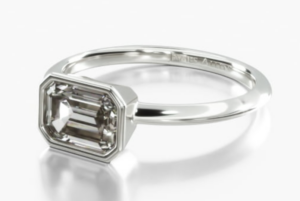
A comparable 14K white gold presentation solitaire (six prong) costs $180.
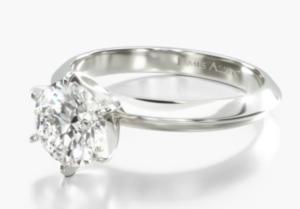
Additionally, this 14K white gold bezel set solitaire engagement ring setting costs $790.
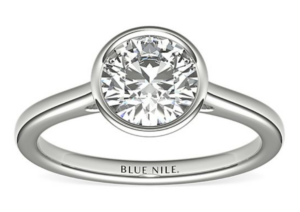
As a comparison, this 14K white gold six-prong setting costs $350.
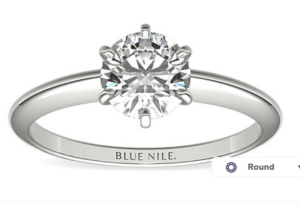
Though the cost can be more than double for a bezel setting, its relative cost to purchasing a diamond makes the premium price more manageable.
How to Decide Between a Prong and Bezel Setting
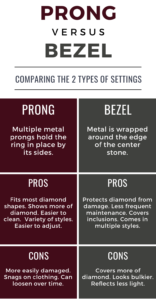
If you’re searching for a diamond ring setting, the two most common styles you’ll come across are prong and bezel. Each have their unique differences and list of pros and cons, so there really is no right decision.
If you want to show off as much of the diamond as possible and enhance its light performance, a four- or six-prong setting is the better fit, but if you want to cover the edges and minimize the chances of damage, there are bezel settings to fit nearly every shape of diamond.
Examine your options for a prong versus bezel setting closely, and whether you’re shopping online or at a jewelry store, request to see each setting and how it enhances the look of your chosen diamond.
You can’t go wrong with either setting, and remember the real focus is the sparkling diamond positioned on top.

Jacob Clarke
Jacob Clarke is the founder of TeachJewelry.com.
He earned an Applied Jewelry Professional Diploma from the Gemological Institute of America (GIA) and now brings you essential information about diamonds, settings, and more.
Jacob has consulted with leading jewelry brands, and his work has been cited in Clean Origin, Diamond Nexus and industry publications.
He's also a member of the International Gem Society.
He enjoys discussing jewelry with readers, so contact him with any questions at jacob.clarke@teachjewelry.com.

